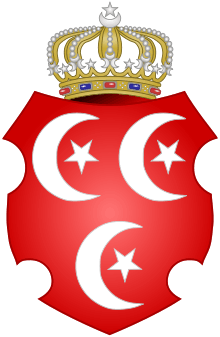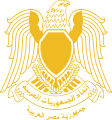Coat of arms of Egypt
| Coat of arms of Egypt | |
|---|---|
.svg.png) | |
| Details | |
| Armiger | Arab Republic of Egypt |
| Adopted | 1984 |
| Escutcheon | Tierced per pale gules, argent, and sable |
| Supporters | The Eagle of Saladin inverted and displayed |
| Motto |
Arabic: جمهورية مصر العربية (Gumhūriyyat Miṣr al-ʿArabiyyah, "Arab Republic of Egypt") |
The coat of arms of Egypt (Arabic: شعار مصر) is a golden eagle looking towards the viewer's left (dexter).
History
The "Eagle of Saladin" was first introduced as a symbol of the Egyptian Revolution of 1952. The current coat of arms was introduced during the Mubarak era, in 1984. In the Egyptian Revolution of 2011, the eagle became associated with the Mubarak regime. Mehrez (2012) describes a stencilled graffiti depicting the "Eagle of Saladin" turned upside down as a call for the regime's downfall.[1]
Appearance
The "Eagle of Saladin" holds a scroll on which the name of the state appears in Arabic script, Gumhūriyyat Miṣr al-ʿArabiyyah ("Arab Republic of Egypt"). The eagle carries on its breast a shield with the flag's colors — but with a vertical instead of a horizontal configuration. When appearing on the national flag, the eagle is rendered entirely in gold and white. During the union with Syria in the United Arab Republic (1958–1961), and in the ten years afterwards when Egypt retained the union's official name, the two green stars of the union's flag appeared in the white band of the eagle's shield. Between 1972–1984 the eagle was replaced by the golden Hawk of Quraish, as part of the symbolism of the Federation of Arab Republics.
 Coat of arms of the Sultanate of Egypt (1914–1922)
Coat of arms of the Sultanate of Egypt (1914–1922) Coat of arms of the Kingdom of Egypt (1922–1953)
Coat of arms of the Kingdom of Egypt (1922–1953).svg.png) Coat of arms of the Republic of Egypt (1953–1958)
Coat of arms of the Republic of Egypt (1953–1958).svg.png) Coat of arms of the United Arab Republic (1958–1971)
Coat of arms of the United Arab Republic (1958–1971) Coat of arms of Egypt within the Federation of Arab Republics, and during the seven years after the Federation's dissolution (1972–1984)
Coat of arms of Egypt within the Federation of Arab Republics, and during the seven years after the Federation's dissolution (1972–1984).svg.png) A version of the coat of arms as it appears on the Flag of Egypt
A version of the coat of arms as it appears on the Flag of Egypt.svg.png) Official Coat of arms of Egypt, 1984–present.
Official Coat of arms of Egypt, 1984–present.
See also
| Wikimedia Commons has media related to Coats of arms of Egypt. |
References
- ↑ "Ganzeer, an Egyptian graphics artist widely known for his revolutionary street art, explains, 'The current "Eagle of Saladin" emblem in the white band of the flag, however, wasn't used until 1984. Which means ... the current eagle on our flag belongs to Mubarak's regime.' This connection of the 'Eagle of Saladin' with the Mubarak regime provides the key to understanding this stencil piece." Samia Mehrez Translating Egypt’s Revolution: The Language of Tahrir (2012), p. 119.
- el Ansary, Nasser (2001). "L'emblème de l'État égyptien" [The emblem of the Egyptian State]. L'Encyclopédie des souverains d'Égypte des pharaons à nos jours [The Encyclopedia of rulers of Egypt from the Pharaohs until today] (in French). Alleur: Éditions du Perron. pp. 138–141. ISBN 978-2-87114-173-0. OCLC 48965345.
External links
- "Historical coats of arms of Egypt" (PDF, 7.63 MB) (in Arabic). Egypt State Information Service. Retrieved 2010-07-13.
